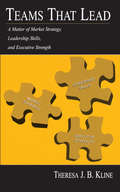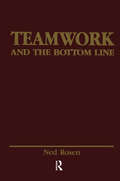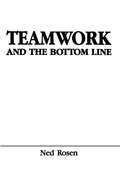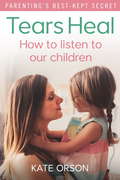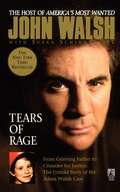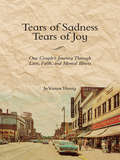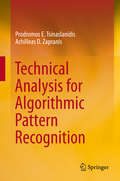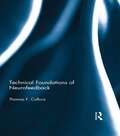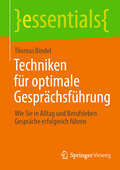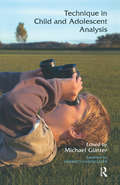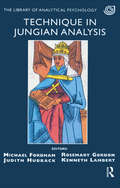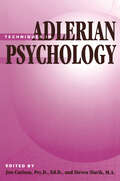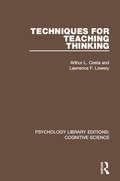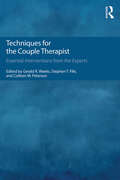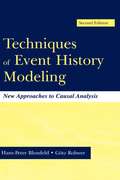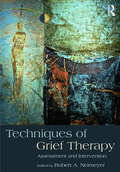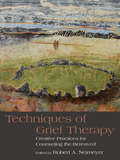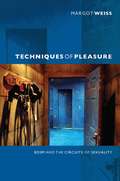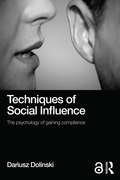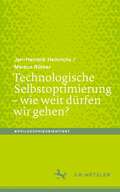- Table View
- List View
Teams That Lead: A Matter of Market Strategy, Leadership Skills, and Executive Strength
by Theresa J.B. KlineTeams That Lead: A Matter of Market Strategy, Leadership Skills, and Executive Strength strikes a balance between the current scholarly literature that exists in these fields and its impact on teams. The focus on leading executive teams makes this book unique. It provides three lenses with which to view team leadership and how those various lenses can assist in making teams more effective. The first focuses on paying close attention to the market strategy of the organization and how it should drive key decisions. The second focuses on the multiple roles of the designated leader of a team. The third focus shifts to executive teams and how to be a highly effective team player in the executive environment. Each section is grounded in theoretical and empirical evidence. How this information can then be translated into useful knowledge for practitioners and researchers follows. To make it practical, however, the book provides examples, cases, measuring tools, and questions. This book will be of interest to students and professors in MBA programs, organizational behavior, public policy, and psychology courses. Practitioners, such as consultants, facilitators, trainers, and executive coaches will also be interested.
Teamwork and the Bottom Line: Groups Make A Difference (Applied Psychology Series)
by Ned RosenThis volume is based on extensive research findings and the author's observation that successful managers are people who understand the dynamics of group interaction and can use that understanding effectively to motivate members of their group to achieve important goals. Blending theory, research, and practice, the book emphasizes a "management through teamwork" strategy in task groups that increases both the quality and quantity of goods and services, improves decision making, and is beneficial to their members. While closely linked to a large body of applied research evidence, Teamwork and the Bottom Line makes liberal use of examples drawn from business oriented publications and from the author's experiences in manufacturing, service, sales, information systems, health care, and other work environments. It includes numerous ideas that can help managers become more secure in their current roles by developing a more complete knowledge base about potential "change levers."
Teamwork and the Bottom Line: Groups Make A Difference (Applied Psychology Series)
by Ned RosenThis volume is based on extensive research findings and the author's observation that successful managers are people who understand the dynamics of group interaction and can use that understanding effectively to motivate members of their group to achieve important goals. Blending theory, research, and practice, the book emphasizes a "management through teamwork" strategy in task groups that increases both the quality and quantity of goods and services, improves decision making, and is beneficial to their members. While closely linked to a large body of applied research evidence, Teamwork and the Bottom Line makes liberal use of examples drawn from business oriented publications and from the author's experiences in manufacturing, service, sales, information systems, health care, and other work environments. It includes numerous ideas that can help managers become more secure in their current roles by developing a more complete knowledge base about potential "change levers."
Teardrop Lane: A heartwarming, uplifting, feel-good romance series (Eternity Springs)
by Emily MarchIf you love Robyn Carr's Virgin River, don't miss Emily March's warm, uplifting Eternity Springs series!Teardrop Lane is the touching ninth novel in New York Times bestselling author Emily March's warm and uplifting romance series about a small town with a big heart. For fans of Debbie Macomber, Holly Martin and Sheryl Woods.Town physician Rose Anderson hides a well of sadness behind her cheerful and capable professionalism. Heartbreak has only reinforced her belief that marriage and children aren't in her future. Yet she's a woman with a pulse - and when sexy, brooding artist Hunt Cicero shows up at her office with his young nephew, the sheer physical attraction he ignites in her is both exciting and unsettling.Hunt has an artist's passionate temperament and a bachelor's lifestyle. So when he becomes guardian to his sister's children, he's riddled with conflict - and in way over his head. Without Rose and her warm maternal instincts, he'd be lost. Still, she's a woman who guards her own heart, and he's a novice when it comes to commitment. Can the healing magic of Eternity Springs shine on this patchwork family and allow Hunt and Rose to trust that love is the fabric holding them together?Escape to Eternity Springs, a little piece of heaven in the Colorado Rockies, with the other books in the series, Hummingbird Lake, Heartache Falls, Mistletoe Mine, Lover's Leap, Nightingale Way, Reflection Point, Miracle Road, Dreamweaver Trail, Teardrop Lane, Heartsong Cottage, Reunion Pass, Christmas In Eternity Springs.
Tears Heal: How to listen to our children
by Kate OrsonOne of the most difficult things parents of babies and young children have to deal with are tears. When babies cry, parents shhh, or rock them to try to get them to stop. When toddlers' tantrum parents may distract them, attempt to reason with them, or ignore their crying in the hope it won't last long. It seems natural to judge the success of parenting by how much children cry. Tears Heal will allow readers to discover parenting's biggest paradigm shift, the way they respond to their children's tears. Here parents will learn how to transform their parenting by moving away from stopping feelings, towards listening instead. Tears Heal explains how children's challenging behaviour comes from unheard feelings and how through simple shifts in how we respond to their upsets we can solve our parenting struggles. Tears Heal is warm, and full of empathy for the hard work, and struggles that parents go through. It also has a strong leaning towards helping parents with their own emotions, as they deal with their children's challenging moments. It explains why we find children's feelings hard to handle, because our feelings weren't fully listened to when we were children, and shows how we can nurture and support ourselves so that we can be the parents we want to be.
Tears of Rage
by John WalshThe host of the America's Most Wanted, John Walsh tells for the first time the full story of the 1981 abduction and murder of his six-year-old son, Adam. This is the heartbreaking chronicle of John Walsh's transformation from grieving father to full-time activist -- and the infuriating conspiracy of events that have kept America's No. 1 crime-fighter from obtaining justice and closure for himself and his family. From the day Adam disappeared from a mall in Hollywood, Florida, John Walsh faced a local police department better equipped to track stolen cars than missing children -- and a criminal justice system that would work against him in unimaginable ways. Outraged but determined, he ultimately enlarged the search for Adam's killer into an exhaustive battle on behalf of all missing and abused children, beginning with his efforts to put missing children's faces on milk cartons. Today, John Walsh continues the fight for legislative change and public awareness, driven by his own personal tragedy. Tears of Rage is the story of a true American hero: a man who challenged the system in the name of his son.
Tears of Sadness, Tears of Joy: One Couple’s Journey Through Love, Faith, and Mental Illness
by Jo Vamos HonigIn the summer of 1956, when Jo met charismatic young preacher Bill Vamos at a Vacation Bible School conference, neither could possibly have predicted the decades-long journey they were about to embark on together. It would bolster-and test-their faith in ways they never could have anticipated.
Technical Analysis for Algorithmic Pattern Recognition
by Achilleas D. Zapranis Prodromos E. TsinaslanidisThe main purpose of this book is to resolve deficiencies and limitations that currently exist when using Technical Analysis (TA). Particularly, TA is being used either by academics as an "economic test" of the weak-form Efficient Market Hypothesis (EMH) or by practitioners as a main or supplementary tool for deriving trading signals. This book approaches TA in a systematic way utilizing all the available estimation theory and tests. This is achieved through the developing of novel rule-based pattern recognizers, and the implementation of statistical tests for assessing the importance of realized returns. More emphasis is given to technical patterns where subjectivity in their identification process is apparent. Our proposed methodology is based on the algorithmic and thus unbiased pattern recognition. The unified methodological framework presented in this book can serve as a benchmark for both future academic studies that test the null hypothesis of the weak-form EMH and for practitioners that want to embed TA within their trading/investment decision making processes.
Technical Foundations for Measuring Ego Development: The Washington University Sentence Completion Test
by Le Xuan HyThis book describes the evolution of the Washington University Sentence Completion Test (SCT), a major measure of ego development, from an intuitive rating scale to an empirically derived reliable and valid personality test. The authors recount the complete history of the SCT, which begins with the Family Problems Scale, an objective test of mothers' attitudes. Work with that test led to a concept of ego development, testable by the SCT, which was elaborated and refined in further work. The book discusses uses of the SCT in other languages and other cultures, offers suggestions for giving the SCT in translation, and presents computer programs for handling SCT responses. Data on reliability and validity of the SCT are brought up to date. These include evidence of the equivalence of the male and female forms of the current version, Form 81, and the equivalence of the two halves of Form 81, each usable as a short form. Rules for obtaining total protocol ratings for 18-item as well as 36-item forms are given. Frequently used forms of the SCT, including a new form for adolescents and children over eight years old, are presented.
Technical Foundations of Neurofeedback
by Thomas F. ColluraTechnical Foundations of Neurofeedback provides, for the first time, an authoritative and complete account of the scientific and technical basis of EEG biofeedback. Beginning with the physiological origins of EEG rhythms, Collura describes the basis of measuring brain activity from the scalp and how brain rhythms reflect key brain regulatory processes. He then develops the theory as well as the practice of measuring, processing, and feeding back brain activity information for biofeedback training. Combining both a "top down" and a "bottom up" approach, Collura describes the core scientific principles, as well as current clinical experience and practical aspects of neurofeedback assessment and treatment therapy. Whether the reader has a technical need to understand neurofeedback, is a current or future neurofeedback practitioner, or only wants to understand the scientific basis of this important new field, this concise and authoritative book will be a key source of information..
Technical and Vocational Education in China
by Xueping Wu Yiqun YeThis book provides comprehensive and up-to-date coverage of research on technical and vocational education in China. It discusses various aspects that range from such conventional topics as teaching at different levels, development history, regulations, policies, curriculum, specialty setup, teaching, faculty and management; to the status quo, transformation and current trends; as well as quantity expansion and quality improvement, all of which highlight the unique characteristics of technical and vocational education in China.This book is intended for researchers and graduate students, and will also help international readers to grasp the general situation regarding technical and vocational education in China. Combining rich content and a broad scope, the book will undoubtedly offer a valuable key to understanding China’s technical and vocational education in the 21st century.
Techniken für optimale Gesprächsführung: Wie Sie in Alltag und Berufsleben Gespräche erfolgreich führen (essentials)
by Thomas BindelThomas Bindel schlägt Ihnen vor, mit welchen Worten Sie in schwierigen Situationen richtig reagieren. Er verrät Ihnen, mit welcher Systematik Sie Gespräche und Verhandlungen perfekt vorbereiten. Und er zeigt Ihnen, wie Sie mit Menschen vertieft ins Gespräch kommen, indem Sie besser zuhören und treffende Fragen stellen. Das vorliegende Buch bietet somit ein Konzentrat aus den wichtigsten Methoden, um Gespräche optimal führen zu können: Ausgestattet mit dem Erfolgsprinzip eines amerikanischen Präsidenten, diversen Denkhüten, passenden Strategien und Techniken für Gesprächsvorbereitung, -führung sowie -nachbereitung übersteht man die Begegnung mit dem Freud&’schen Eisberg und findet so zu einer Kommunikation, die durch ein Quadrat runder läuft und gewaltfrei mehr erreicht.
Technique in Child and Adolescent Analysis
by Michael Günter Harriett HasencleverThese are the edited papers from a conference held in 2008 on the topic of problems with child and adolescent analysis. The contributors come from widely differing theoretical backgrounds and use a broad variety of metapsychological concepts, among them contemporary Kleinian, post-Bionian classical Freudian. This collection helps widen our understanding of technique with children and adolescents and together they show a very modern psychoanalytic technique may be emerging from modern recent work with children and adolescents.
Technique in Jungian Analysis (The\library Of Analytical Psychology Ser.)
by Kenneth Lambert Michael Fordham Rosemary Gordon Judith HubbackThis volume will be of enormous interest and value to the growing number of people qualified both in the established and the new training societies for analysts and therapists, or studying to enter them. Within it theory and practice are closely interwoven, demonstrating how theories and models emerge, both from the study of earlier pioneering publications and from day to day experience, and are tested time and time again in the process of a group of practitioners accepting them as viable. An impressive and creative blend of the characteristics which this profession demands of its practitioners is in evidence here, combining originality with passion for their subject and the flexibility required to develop their own pattern of thought. 'In the practice of modern analytical psychology it has become of central importance to reorganise, analyse and interpret projections and introjections of many sorts, the patient's transference, the analyst's counter-transference, and the dialectical interaction between the two, which is descriptively termed transference/counter-transference.
Techniques In Adlerian Psychology
by Jon Carlson Steven SlavikFirst published in 1998. Routledge is an imprint of Taylor & Francis, an informa company.
Techniques for Teaching Thinking (Psychology Library Editions: Cognitive Science)
by Lawrence F. Lowery Arthur CostaOriginally published in 1989 the purpose of this title was to provide information and ideas for: Staff Developers and Teacher Educators, as they consider program content to prepare teachers to teach thinking skills. Teachers, as they assess their own abilities to create classroom conditions for thinking and their readiness to implement a curriculum for developing thinking skills. Curriculum Developers, as they decide how the curriculum should be organized and sequenced according to children’s developmental levels. Administrators, as they assess and provide leadership for improving the conditions in their schools and classrooms, which allows the stimulating teaching of thinking. Although written some time ago the information is still valid today.
Techniques for the Couple Therapist: Essential Interventions from the Experts
by Gerald R. Weeks Stephen T. Fife Colleen M. PetersonTechniques for the Couple Therapist features many of the most prominent psychotherapists today, presenting their most effective couple therapy interventions. This book provides clinicians with a user-friendly quick reference with an array of techniques that can be quickly read and immediately used in session. The book includes over 50 chapters by experts in the field on the fundamental principles and techniques for effective couple therapy. Many of the techniques focus on common couple therapy processes such as enactments, communication, and reframing. Others focus on specific presenting problems, such as trauma, sexual issues, infidelity, intimate partner violence, and high conflict. Students, beginning therapists, and seasoned clinicians will find this pragmatic resource invaluable in their work with couples.
Techniques in Marriage and Family Counseling
by Richard E. WattsEighteen chapters covering assessment, transgenerational, and constructive techniques share contributors' adaptations of the family counseling literature to clinical realities. Appends The How I Remember My Family Questionnaire. Lacks an index.
Techniques of Event History Modeling: New Approaches to Casual Analysis
by Hans-Peter Blossfeld G”tz RohwerIncluding new developments and publications which have appeared since the publication of the first edition in 1995, this second edition: *gives a comprehensive introductory account of event history modeling techniques and their use in applied research in economics and the social sciences; *demonstrates that event history modeling is a major step forward in causal analysis. To do so the authors show that event history models employ the time-path of changes in states and relate changes in causal variables in the past to changes in discrete outcomes in the future; and *introduces the reader to the computer program Transition Data Analysis (TDA). This software estimates the sort of models most frequently used with longitudinal data, in particular, discrete-time and continuous-time event history data. Techniques of Event History Modeling can serve as a student textbook in the fields of statistics, economics, the social sciences, psychology, and the political sciences. It can also be used as a reference for scientists in all fields of research.
Techniques of Grief Therapy: Assessment and Intervention (Series in Death, Dying, and Bereavement)
by Robert A. NeimeyerTechniques of Grief Therapy: Assessment and Intervention continues where the acclaimed Techniques of Grief Therapy: Creative Practices for Counseling the Bereaved left off, offering a whole new set of innovative approaches to grief therapy to address the needs of the bereaved. This new volume includes a variety of specific and practical therapeutic techniques, each conveyed in concrete detail and anchored in an illustrative case study. Techniques of Grief Therapy: Assessment and Intervention also features an entire new section on assessment of various challenges in coping with loss, with inclusion of the actual scales and scoring keys to facilitate their use by practitioners and researchers. Providing both an orientation to bereavement work and an indispensable toolkit for counseling survivors of losses of many kinds, this book belongs on the shelf of both experienced clinicians and those just beginning to delve into the field of grief therapy.
Techniques of Grief Therapy: Creative Practices for Counseling the Bereaved (Series in Death, Dying, and Bereavement)
by Robert A. NeimeyerTechniques of Grief Therapy is an indispensable guidebook to the most inventive and inspirational interventions in grief and bereavement counseling and therapy. Individually, each technique emphasizes creativity and practicality. As a whole, they capture the richness of practices in the field and the innovative approaches that clinicians in diverse settings have developed, in some cases over decades, to effectively address the needs of the bereaved. New professionals and seasoned clinicians will find dozens of ideas that are ready to implement and are packed with useful features, including: Careful discussion of the therapeutic relationship that provides a "container" for specific procedures An intuitive, thematic organization that makes it easy to find the right technique for a particular situation Detailed explanations of when to use (and when not to use) particular techniques Expert guidance on implementing each technique and tips on avoiding common pitfalls Sample worksheets and activities for use in session and as homework assignments Illustrative case studies and transcripts Recommended readings to learn more about theory, research and practice associated with each technique
Techniques of Pleasure: BDSM and the Circuits of Sexuality
by Margot WeissTechniques of Pleasure is a vivid portrayal of the San Francisco Bay Area's pansexual BDSM (SM) community. Margot Weiss conducted ethnographic research at dungeon play parties and at workshops on bondage, role play, and flogging, and she interviewed more than sixty SM practitioners. She describes a scene devoted to a form of erotic play organized around technique, rules and regulations, consumerism, and self-mastery. Challenging the notion that SM is inherently transgressive, Weiss links the development of commodity-oriented sexual communities and the expanding market for sex toys to the eroticization of gendered, racialized, and national inequalities. She analyzes the politics of BDSM's spectacular performances, including those that dramatize heterosexual male dominance, slave auctions, and US imperialism, and contends that the SM scene is not a "safe space" separate from real-world inequality. It depends, like all sexual desire, on social hierarchies. Based on this analysis, Weiss theorizes late-capitalist sexuality as a circuit--one connecting the promise of new emancipatory pleasures to the reproduction of raced and gendered social norms.
Techniques of Social Influence: The psychology of gaining compliance
by Dariusz DolinskiEvery day we are asked to fulfil others’ requests, and we make regular requests of others too, seeking compliance with our desires, commands and suggestions. This accessible text provides a uniquely in-depth overview of the different social influence techniques people use in order to improve the chances of their requests being fulfilled. It both describes each of the techniques in question and explores the research behind them, considering questions such as: How do we know that they work? Under what conditions are they more or less likely to be effective? How might individuals successfully resist attempts by others to influence them? The book groups social influence techniques according to a common characteristic: for instance, early chapters describe "sequential" techniques, and techniques involving egotistic mechanisms, such as using the name of one’s interlocutor. Later chapters present techniques based on gestures and facial movements, and others based on the use of specific words, re-examining on the way whether "please" really is a magic word. In every case, author Dariusz Dolinski discusses the existing experimental studies exploring their effectiveness, and how that effectiveness is enhanced or reduced under certain conditions. The book draws on historical material as well as the most up-to-date research, and unpicks the methodological and theoretical controversies involved. The ideal introduction for psychology graduates and undergraduates studying social influence and persuasion, Techniques of Social Influence will also appeal to scholars and students in neighbouring disciplines, as well as interested marketing professionals and practitioners in related fields.
Technological Innovations in Participatory Health Research with Adolescents
by Leonor Rodriguez-EstradaThis book offers a critical overview of participatory methods in health research with adolescents and youth. It introduces participatory methodology as an ethos and practice, before covering specific paradigms and methods, including participatory action research, community-based participatory research, co-design, co-creation, participatory design, peer research, youth as researchers, integrated knowledge translation, and youth-adult partnerships. Specific technologies are also covered, such as mobile apps and video games, sonification, photovoice, visual mapping, and Internet-based approaches. A guidebook to both theory and methods, it demonstrates technology's potential to drive impactful research and inclusive study design.
Technologische Selbstoptimierung – wie weit dürfen wir gehen? (#philosophieorientiert)
by Jan-Hendrik Heinrichs Markus RütherTechnologische Selbstoptimierung ist gegenwärtig in aller Munde. Sie umfasst die Erforschung neuer Möglichkeiten im Hinblick auf Schönheitsoperationen, funktionale Implantologie, Gehirndoping oder die Verlängerung der Lebensspanne. Gegenüber vielen dieser technischen Mittel, die oft nicht legal verfügbar sind, bestehen erhebliche gesellschaftliche Vorbehalte. Jan-Hendrik Heinrichs und Markus Rüther plädieren bei ihrer ethischen Einschätzung für eine Differenzierung der Perspektive: Die Vorbehalte sind nämlich ihrer Meinung nach nicht geeignet, gesellschaftliche Ächtung oder gar verbindliche Verbote für alle zu begründen. Vielmehr habe die Freiheit zur Selbstgestaltung Vorrang, was jedoch nicht heißt, dass es für manche Bereiche nicht auch klare Regeln geben muss. Weil Selbstgestaltung aber nur frei sein kann, wenn sie informiert ist, argumentieren die Autoren für Regelungen, die von weitgehenden Informationspflichten statt von Verboten bestimmt sind. Aus einer individuellen Sicht heraus lassen sich zudem eine Reihe von moralischen Empfehlungen formulieren, die zwar nicht eingefordert werden können, aber einen ethischen Kompass bilden, um sich im Dickicht der ethischen Debatte an guten Gründen zu orientieren.
